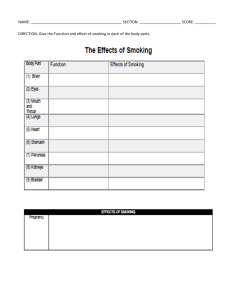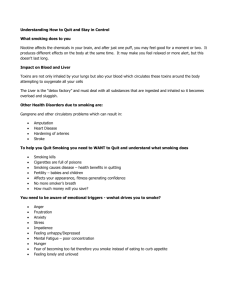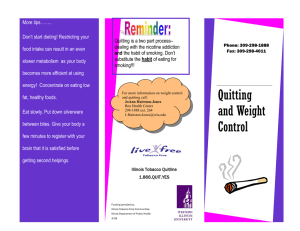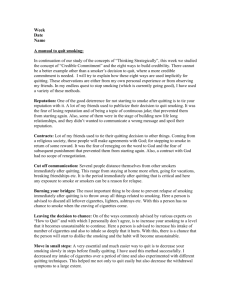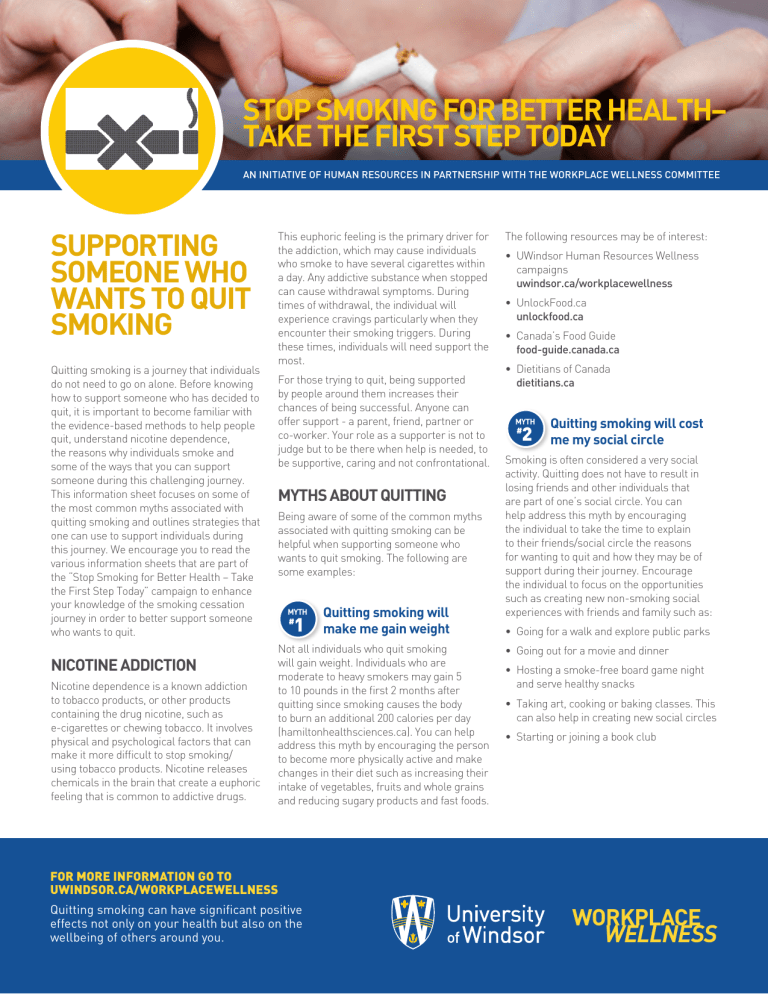
STOP SMOKING FOR BETTER HEALTH– TAKE THE FIRST STEP TODAY AN INITIATIVE OF HUMAN RESOURCES IN PARTNERSHIP WITH THE WORKPLACE WELLNESS COMMITTEE SUPPORTING SOMEONE WHO WANTS TO QUIT SMOKING Quitting smoking is a journey that individuals do not need to go on alone. Before knowing how to support someone who has decided to quit, it is important to become familiar with the evidence-based methods to help people quit, understand nicotine dependence, the reasons why individuals smoke and some of the ways that you can support someone during this challenging journey. This information sheet focuses on some of the most common myths associated with quitting smoking and outlines strategies that one can use to support individuals during this journey. We encourage you to read the various information sheets that are part of the “Stop Smoking for Better Health – Take the First Step Today” campaign to enhance your knowledge of the smoking cessation journey in order to better support someone who wants to quit. NICOTINE ADDICTION Nicotine dependence is a known addiction to tobacco products, or other products containing the drug nicotine, such as e-cigarettes or chewing tobacco. It involves physical and psychological factors that can make it more difficult to stop smoking/ using tobacco products. Nicotine releases chemicals in the brain that create a euphoric feeling that is common to addictive drugs. This euphoric feeling is the primary driver for the addiction, which may cause individuals who smoke to have several cigarettes within a day. Any addictive substance when stopped can cause withdrawal symptoms. During times of withdrawal, the individual will experience cravings particularly when they encounter their smoking triggers. During these times, individuals will need support the most. For those trying to quit, being supported by people around them increases their chances of being successful. Anyone can offer support - a parent, friend, partner or co-worker. Your role as a supporter is not to judge but to be there when help is needed, to be supportive, caring and not confrontational. MYTHS ABOUT QUITTING Being aware of some of the common myths associated with quitting smoking can be helpful when supporting someone who wants to quit smoking. The following are some examples: MYTH # 1 Quitting smoking will make me gain weight Not all individuals who quit smoking will gain weight. Individuals who are moderate to heavy smokers may gain 5 to 10 pounds in the first 2 months after quitting since smoking causes the body to burn an additional 200 calories per day (hamiltonhealthsciences.ca). You can help address this myth by encouraging the person to become more physically active and make changes in their diet such as increasing their intake of vegetables, fruits and whole grains and reducing sugary products and fast foods. The following resources may be of interest: • UWindsor Human Resources Wellness campaigns uwindsor.ca/workplacewellness • UnlockFood.ca unlockfood.ca • Canada’s Food Guide food-guide.canada.ca • Dietitians of Canada dietitians.ca MYTH # 2 Quitting smoking will cost me my social circle Smoking is often considered a very social activity. Quitting does not have to result in losing friends and other individuals that are part of one’s social circle. You can help address this myth by encouraging the individual to take the time to explain to their friends/social circle the reasons for wanting to quit and how they may be of support during their journey. Encourage the individual to focus on the opportunities such as creating new non-smoking social experiences with friends and family such as: • Going for a walk and explore public parks • Going out for a movie and dinner • Hosting a smoke-free board game night and serve healthy snacks • Taking art, cooking or baking classes. This can also help in creating new social circles • Starting or joining a book club FOR MORE INFORMATION GO TO UWINDSOR.CA/WORKPLACEWELLNESS Quitting smoking can have significant positive effects not only on your health but also on the wellbeing of others around you. WORKPLACE WELLNESS STOP SMOKING FOR BETTER HEALTH– TAKE THE FIRST STEP TODAY AN INITIATIVE OF HUMAN RESOURCES IN PARTNERSHIP WITH THE WORKPLACE WELLNESS COMMITTEE MYTH # 3 Smoking helps me to manage stress and keep calm People who smoke often say that they feel less stressed after a cigarette, particularly in times of increased stress. What people actually feel is a decrease in their nicotine withdrawal symptoms and they may also feel less stressed because they have taken some time away from their stressor. However, smoking does quite the opposite, it increases the heart rate, tightens blood vessels, tenses muscles and allows less oxygen to reach the brain. Encourage the individual to try other healthier ways to manage stress. For instance, going for a walk, meditating or doing breathing exercises, etc. MYTH # 4 I have smoked for so long, the damage to my health is already done Regardless of how long the person has been smoking, benefits of quitting can be felt almost immediately. Quitting smoking can add years to their lives and improve their quality of life. The chart below outlines some of the health benefits. Share this information to help them see how quickly the body bounces back after quitting smoking. (Source: Canadian Cancer Society, 2020) STRATEGIES TO SUPPORT SOMEONE WHO WANTS TO QUIT Quitting smoking is a major life change which can be surrounded by stress, anxiety, fears, worries and uncertainty. Below are examples of some simple ways to support someone who wants to quit. WAY # 1 Listen without judgement Being available to talk through concerns and worries is key. The individual may want to talk to you to distract themselves during difficult times or to discuss challenges that they may be facing in their quitting journey. It is important to remember to withhold judgement and personal biases to prevent these from taking over the conversation. Remember that you are there to support them and not to put your beliefs and judgements about smoking on the individual. WAY # 2 Address their fears Someone who smokes may have different reasons why they cannot stop smoking. The most critical are the fear of the unknown and the fear of failure. Taking the time to help them address such fears can enhance their success at quitting. The fear of the unknown may weigh heavily on their minds due to witnessing the failed attempts of others or perhaps their own previous relapses. Assure them that it can take many attempts to quit smoking successfully and not to get disheartened by lapses or relapses. Let them know that you will be there to support them and celebrate each attempt to quit whatever the outcome. WAY # 3 Help avoid triggers Triggers can be common places, activities, emotions and even people that the person associates with smoking and therefore signaling to them to smoke. Some examples of pattern triggers include: • Drinking coffee • Drinking alcoholic beverages • Watching TV • Taking a break at work • Driving • Inactivity There are also many emotional triggers such as feeling stressed, bored, lonely, anxious, etc. and social triggers such as occasions that typically include other people who smoke. Help the individual recognize and understand their triggers in order to identify coping mechanisms. For example: • Change their routine – drink coffee at a different time • Find a replacement – chew gum • Get moving – go for a walk • Try activities to keep their hands busy – squeeze a stress ball • Listen to calming music • Avoid places where people smoke FOR MORE INFORMATION GO TO UWINDSOR.CA/WORKPLACEWELLNESS Quitting smoking can have significant positive effects not only on your health but also on the wellbeing of others around you. WORKPLACE WELLNESS STOP SMOKING FOR BETTER HEALTH– TAKE THE FIRST STEP TODAY AN INITIATIVE OF HUMAN RESOURCES IN PARTNERSHIP WITH THE WORKPLACE WELLNESS COMMITTEE SUPPORTING SOMEONE THROUGH THE SLIPS AND FALLS Quitting may not often happen after a first try, slips and falls will happen as part of the quit journey. Remind the individual that these are a normal part of the journey to quitting and remind them that they don’t have to do it alone. BENEFITS OF QUITTING SMOKING Source: Canadian Cancer Society (smokershelpline.ca) Slip Fall Slip is an occurrence of smoking one cigarette or taking a puff due to a moment of weakness after quit day. Typically, the person realizes that it was a mistake and will continue their goal of quitting. Emphasize that slips are common and reassure them of their goal of quitting. Support their commitment and remind them that mistakes are part of the journey. Celebrate each smoke-free milestone that they achieve such as a day, a week and a month. Falls, or relapses, are times when individuals return to smoking after a quitting interval. Remind them that they should feel proud of the time they went without smoking and help them reflect on the coping mechanisms that helped them in the past to avoid triggers and beat cravings. Encourage them to restart quitting right away and not to give up on their smoke-free goal. 8 HOURS AFTER QUITTING: 3 MONTHS AFTER QUITTING: 1 YEAR AFTER QUITTING: 15 YEARS AFTER QUITTING: Carbon monoxide levels decrease. Oxygen levels increase. Blood circulation improves, and lung function increases up to 30 per cent. Risk of heart attack decreases by 50 per cent. Risk of heart disease decreases to the level of someone who has never smoked. 20 MINUTES AFTER QUITTING: 2 DAYS AFTER QUITTING: 6 MONTHS AFTER QUITTING: 10 YEARS AFTER QUITTING: Blood pressure and heart rate decrease. Senses of taste and smell improve. Risk of heart attack decreases. Coughing, fatigue, shortness of breath and congestion all decrease. Risk of lung cancer decreases by up to 50 per cent. The benefits of quitting smoking are many. If you would like support to quit smoking, please visit smokershelpline.ca FOR MORE INFORMATION GO TO UWINDSOR.CA/WORKPLACEWELLNESS Quitting smoking can have significant positive effects not only on your health but also on the wellbeing of others around you. WORKPLACE WELLNESS
